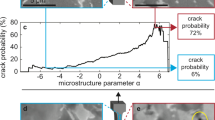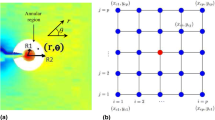Abstract
The longitudinal Varestraint test is the most widely used technique to quantify the weld solidification cracking susceptibility, which provides the total crack length, TCL, as an indicator. But experimental work requires a significant amount of time and resource. Data-driven approaches can serve as alternatives to estimate the TCL through influencing factors, including metallurgical factors, welding conditions, and test parameters. We develop the least-squares boosting model to predict the TCL, a solidification cracking susceptibility indicator, based on the alloy composition, welding parameters, and applied strain. The model manifests high accuracy and stability, and applies to a wide range of stainless steels. It serves as a fast, robust, and low-cost tool for the assessment of solidification cracking susceptibility.




Similar content being viewed by others
References
G. Agarwal, A. Kumar, I.M. Richardson, and M.J.M. Hermans, Mater. Design, 2019, 183, p. 108104.
J. Yoo, B. Kim, Y. Park, and C. Lee, Journal of Materials Science, 50(1), 2015, pp. 279–286.
J. Schwartz, C.C. Koch, Y. Zhang, and X. Liu: U.S. Patent US9773962B2, September 26, 2017.
Y. Zhang, S. Johnson, G. Naderi, M. Chaubal, A. Hunt, and J. Schwartz, Superconductor Science and Technology, 2016, 29(9), 095012.
Y. Zhang, C.C. Koch, and J. Schwartz, Superconductor Science and Technology, 2016, 29(12), 125005.
Y. Zhang, C.C. Koch, and J. Schwartz, Superconductor Science and Technology, 2014, 27(5), 055016.
V. Shankar, T.P.S. Gill, S.L. Mannan, and S. Sundaresan, Sadhana, 2003, 28(3–4), pp. 359–382.
G.J. Ram, T.K. Mitra, V. Shankar, and S. Sundaresan, Journal of Materials Processing Technology, 2003, 142(1), pp. 174–181.
E. Cicală, G. Duffet, H. Andrzejewski, D. Grevey, and S. Ignat, Materials Science and Engineering: A, 2005, 395(1–2), pp. 1–9.
V.S.R. Murti, P.D. Srinivas, G.H.D. Banadeki, and K.S. Raju, Journal of Materials Processing Technology, 1993, 37(1–4), pp. 723–729.
D.G. Eskin and L. Katgerman, Progress in Materials Science, 2004, 49(5), pp. 629–711.
T. Soysal and S. Kou, Acta Materialia, 2018, 143, pp. 181–197.
A. Niel, C. Bordreuil, F. Deschaux-Beaume, and G. Fras, Science and Technology of Welding and Joining, 2013, 18(2), pp. 154–160.
B.G. Thomas, ASM Handbook, 2009, 22, pp. 362–374.
Y. Zhang and X. Xu, International Journal of Thermophysics, 2020, 41, 149.
Y. Zhang and X. Xu: N. J. Chem., 2020, 44, 20544–20567.
Y. Zhang and X. Xu, Computational Materials Science, 2020, 179, 109583.
Y. Zhang and X. Xu, Physica C: Superconductivity and its Applications, 2020, 573, 1353633.
Y. Zhang and X. Xu, Journal of Magnetism and Magnetic Materials, 2020, 512, 166998.
Y. Zhang and X. Xu, Applied Physics A, 2020, 126, 341.
Y. Zhang and X. Xu, AIP Advances, 2020, 10(3), 035220.
Y. Zhang and X. Xu, Physics Letters A, 2020, 384, 126500.
Y. Zhang and X. Xu, AIP Advances, 2020, 10, 045121.
Y. Zhang and X. Xu, Optik, 2020, 217, 164808.
Y. Zhang and X. Xu, RSC Advances, 2020, 10, 20646–653.
Y. Zhang and X. Xu, ACS Omega, 2020, 5, 15344–15352.
Y. Zhang and X. Xu, CrystEngComm, 2020, 22, 6385–6397.
Y. Zhang and X. Xu, ChemistrySelect, 2020, 5, 9999–10009.
Y. Zhang and X. Xu: Met. Mater. Int., 2020. https://doi.org/10.1007/s12540-020-00883-7.
Y. Zhang and X. Xu, Physics and Chemistry of Minerals, 2020, 47, 39.
Y. Zhang and X. Xu: Shape Mem. Superelast., 2020, 6, 374–386.
Y. Zhang and X. Xu: Int. J. Quantum Chem., 2020. https://doi.org/10.1002/QUA.26480.
Y. Zhang and X. Xu: J. Low Temp. Phys., 2020. https://doi.org/10.1007/s10909-020-02545-9.
Y. Zhang and X. Xu: J. Mater. Eng. Perform., 2020, 29, 6605–6616.
Y. Zhang and X. Xu: Int. J. Mater. Res., 2020. https://doi.org/10.3139/146.111975.
Y. Zhang and X. Xu, Heliyon, 2020, 6, e05055.
Y. Zhang and X. Xu: J. Supercond. Nov. Magn., 2020. https://doi.org/10.1007/s10948-020-05682-0.
Y. Zhang and X. Xu: Mater. Technol., 2020. https://doi.org/10.1080/10667857.2020.1830567
Y. Zhang and X. Xu, Chemical Physics Letters, 2020, 760, 137993.
Y. Zhang and X. Xu: J. Mol. Graph. Model., 2021, 103, art. no. 107796.
Y. Zhang and X. Xu: Mach. Learn. Appl., 2021, 3, art. no. 100010.
S. Feng, H. Zhou, and H. Dong, Materials & Design, 2019, 162, pp. 300–310.
L. Breiman, Machine Learning, 2001, 45(1), pp. 5–32.
T. Hastie, R. Tibshirani, and J. Friedman, The Elements of Statistical Learning, Springer, New York, 2009.
A.D. Bull, J. Mach. Learn. Res., 2011, 12, 2879–2904.
M.A. Gelbart, J. Snoek, and R.P. Adams: Mach. Learn, 2014. https://arxiv.org/abs/1403.5607v1.
Y. Arata, F. Matsuda, and S. Saruwatari, Transactions of JWRI, 1974, 3(1), pp. 79–88.
J.A. Brooks and W.M. Garrison: Weld. J. N. Y., 1999, 78, pp. 280-s.
M.J. Cieslak and W.F. Savage: Doctoral Dissertation, Rensselaer Polytechnic Institute, May 1979.
D.H. Kah and D.W. Dickinson: Weld J., 1981, 60, p. 135s.
L. Li and R.W. Messler Jr., Weld. J. N. Y., 1999, 78, pp. 387-s.
J.C. Lippold, Welding Journal, 1983, 63(3), p. 91.
C.D. Lundin, C.Y.P. Qiao, Y. Kikuchi, C. Shi, and T.P.S. Gill: No. ORNL/Sub-88-07685/02, Oak Ridge National Laboratory, TN.
C.D. Lundin, C.H. Lee, and C.Y.P. Qiao, Weld. J. N. Y., 1993, 72, pp. 321-s.
C.D. Lundin, C.Y.P. Qiao, C.H. Lee, and G. Batten, Weld. Res. Council Bull., 2006, 509, p. 1.
C.D. Lundin, C.Y.P. Qiao, T.P.S. Gill, and G.M. Goodwin, Weld. J. N. Y., 1993, 72, pp. 189-s.
H. Madarame, T. Sukegawa, and H. Inoue, Fusion Engineering and Design, 1995, 27, pp. 499–506.
T. Ogawa and T. Koseki, Welding Journal, 1988, 67(1), pp. 8s–17s.
T. Ogawa and E. Tsunetomi, Welding Journal, 1982, 61(3), p. 82.
A.M. Ritter and W.F. Savage, Metallurgical Transactions A, 1986, 17(4), pp. 727–737.
C.V. Robino, J.R. Michael, and M.C. Maguire, Weld. J. N. Y., 1998, 77, pp. 446-s.
S. Shono, O. Matsumoto, S.I. Kawaguchi, and T. Urabe, Transactions of the Iron and Steel Institute of Japan, 1984, 24(7), pp. 557–565.
I. Varol, W.A. Baeslack III, and J.C. Lippold, Metallography, 1989, 23(1), pp. 1–19.
M. Zaghloul, A. Sadek, A. El-Batahgy, M. Hanafy, Yosetsu Gakkai Ronbunshu, 1994, 12(3), 335–341.
K. Kadoi, S. Okano, S. Yamashita, D. Abe, A. Takemori, S. Yamada, A. Takada, J. Kawata, Q. J. Jpn Weld. Soc., 2019, 37, 200–207.
D. Statharas, H. Atkinson, R. Thornton, J. Marsden, H. Dong, and S. Wen, Metallurgical and Materials Transactions A, 2019, 50A(4), 1748–1762.
S.P. Zhu, Y.Z. Hao, D. Liao, Applied Mathematical Modelling, 2020, 78, 383–398.
S. Kumar, M. Ahmed, S.K. Panthi, Journal of Failure Analysis and Prevention, 2020, 20(4), 1212–1228.
S. Sajith, K.S.R.K. Murthy, P.S. Robi, International Journal of Fatigue, 2020, 130, 105285.
D.S. Konadu, P.G.H. Pistorius: Weld World, 2020, 64, 987–997.
Author information
Authors and Affiliations
Corresponding author
Additional information
Publisher's Note
Springer Nature remains neutral with regard to jurisdictional claims in published maps and institutional affiliations.
Manuscript submitted September 18, 2020; accepted December 13, 2020.
Rights and permissions
About this article
Cite this article
Zhang, Y., Xu, X. Predictions of the Total Crack Length in Solidification Cracking Through LSBoost. Metall Mater Trans A 52, 985–1005 (2021). https://doi.org/10.1007/s11661-020-06130-3
Received:
Accepted:
Published:
Issue Date:
DOI: https://doi.org/10.1007/s11661-020-06130-3




